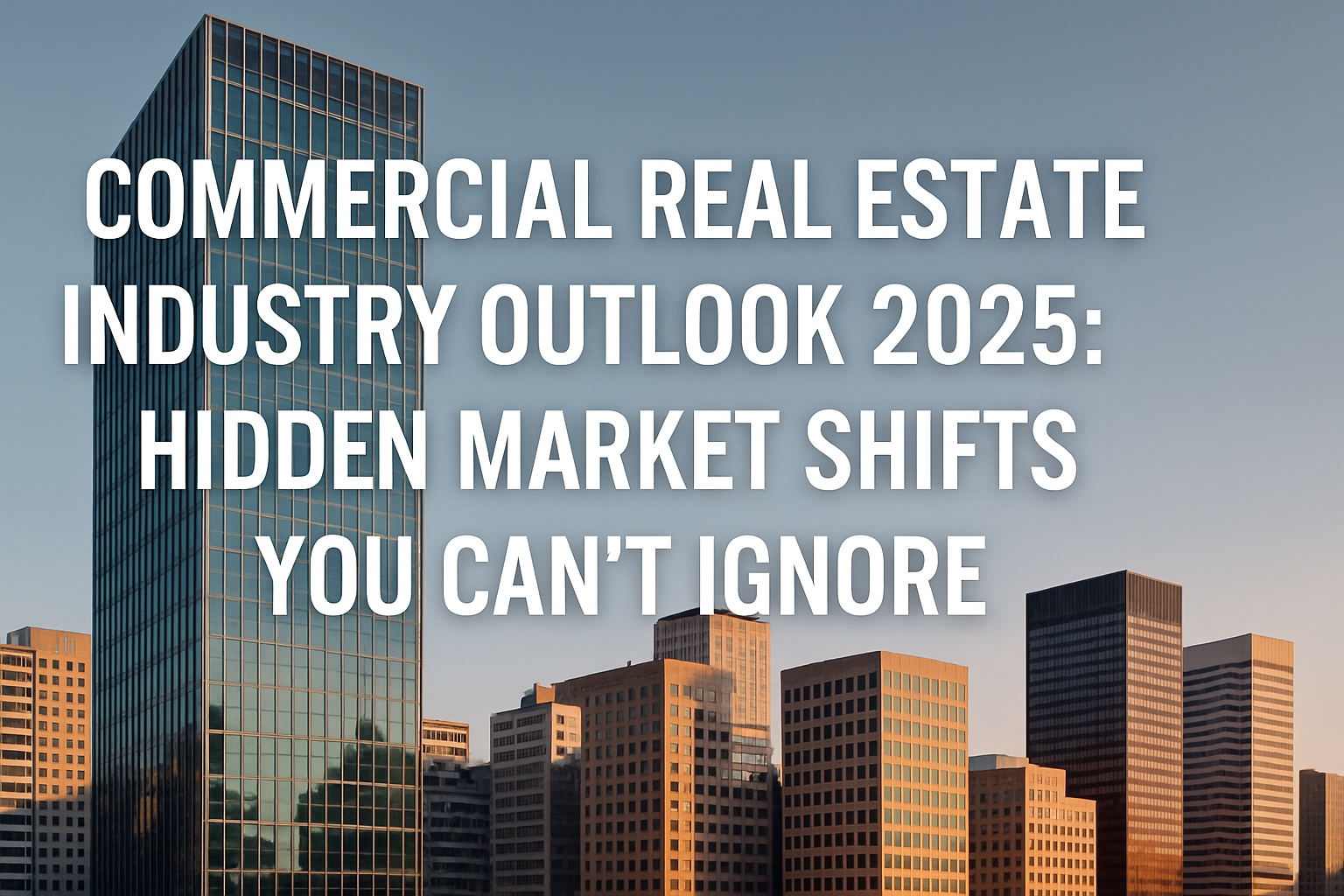Real estate executives worldwide paint an optimistic picture for 2025, with 88% expecting higher revenues. This marks a dramatic turnaround from the time 60% predicted declines. Smart investors must consider the uneven performance between different sectors to build effective strategies.
The industrial sector maintains its robust position as vacancy rates hold steady at 6.8%, which sits below pre-pandemic levels. Office buildings face mounting pressure with vacancy rates hitting an unprecedented 19.6%. Markets like Austin and Nashville show signs of overbuilding in multifamily properties. Yet this sector’s net absorption has doubled from last year’s figures. Hotel occupancy rates now stand just 0.6% below pre-pandemic benchmarks, indicating the sector’s strong comeback. The Fed’s interest rate reductions planned for 2024 should drive transaction volumes up by a lot. Market experts predict a 25-30% jump in loan originations compared to 2023’s low points.
Macroeconomic Forces Shaping 2025
The commercial real estate industry’s future in 2025 depends on monetary policy changes, how different regions perform economically, and the way investors adapt their strategies. These factors will shape which property sectors and markets offer the best investment opportunities this year.
Interest rate trajectory and inflation outlook
The Federal Reserve’s new direction changes how commercial real estate gets financed. The Fed cut rates three times in late 2024 and brought its benchmark rate down to 4.5%. This marks a big change after years of tighter monetary policy. Notwithstanding that, inflation stays just above the Fed’s 2% target at 2.7%.
The Fed will likely keep easing rates. Experts think the federal funds rate might drop to about 3.9% by late 2025. But this path isn’t certain. The 10-year Treasury yield—a significant benchmark for real estate financing—should stay above 4% through 2025. This creates ongoing challenges for property values and deals.
New policies might affect inflation rates, which makes the interest rate outlook more complex. Trade policy changes and proposed tariffs could spark inflation again. This might force the Fed to stop cutting rates. Real estate investors should remember that even with lower benchmark rates, debt costs might stay higher than before the pandemic.
Global GDP forecasts and regional variations
Growth projections for 2025 show clear differences between regions that will affect how commercial real estate performs:
- Eurozone: Growth should hit 1.2% in 2025, up from 0.8% in 2024, with services doing better than manufacturing
- Spain: Should lead European growth at 2.5%—twice the eurozone average
- Nordic region: Expected to grow about 2% in 2025, better than 1.1% in 2024
- Poland: Growth might reach 3.5%, if German economy recovers
- UK: Starts 2025 with weak business confidence despite low unemployment
These differences will shape how investors allocate their money. Markets that grow faster usually have stronger property fundamentals, though this isn’t always true. Real wages should grow in several markets in 2025. This growth will boost consumer demand and help retail and multifamily sectors.
Investor sentiment and capital availability
Money for commercial real estate remains plentiful despite economic uncertainty. About 70% of investors want to buy more commercial real estate than last year, which shows growing confidence. This new optimism comes in part from good pricing, as most investors say this makes them want to invest more.
Deal numbers prove this positive trend. Global direct transactions hit $185 billion in Q1 2025, jumping 34% from last year. Every major region saw growth—Americas (37%), EMEA (41%), and Asia Pacific (20%). Cross-border investment grew 57% year-over-year in Q1, reaching its highest first-quarter level since 2022.
Debt markets look better too. Large amounts of capital wait to be invested, and banks seem more willing to lend with fewer regulations. Then, even with interest rate uncertainty, 56% of investors would accept one year of negative leverage. This shows they believe property values will rise long-term.
High-net-worth investors and family offices who want to exploit these economic changes need a focused strategy based on regional economic strengths and changing capital markets. [Think over scheduling a strategy call with Primior to discuss what these changes mean for your investment portfolio: https://primior.com/start/]
Sector-by-Sector Breakdown: What’s Rising and What’s Falling
Let’s take a closer look at how different commercial real estate sectors are performing in 2025. The contrasts between property types are stark. Investors need to understand these differences to build strong portfolios.
Industrial: Resilience amid slower absorption
The industrial sector remains remarkably strong, even as absorption rates cool down from pandemic peaks. National vacancy rates sit at 6.8%. This is nowhere near historical averages despite recent upticks. First-quarter absorption dropped 30% year-over-year but stayed positive at 26 million square feet.
Rent growth shines as a highlight. National asking rents have climbed to $9.50 per square foot – a 5.2% increase from last year. New construction has slowed substantially, with completions falling 44% compared to 2024.
Regional differences tell an interesting story. The Northeast leads the pack in performance. The Southeast market struggles with oversupply because developers rushed to meet pandemic demand. Smaller industrial properties (under 100,000 square feet) show better stability than mega-warehouses and might offer better investment potential.
Multifamily: Demand vs. overbuilding
The multifamily sector paints an interesting picture for 2025. Improving fundamentals mix with ongoing overbuilding concerns. Net absorption has more than doubled year-over-year in Q1, reaching 82,500 units compared to 40,000 units last year. Occupancy rates have found stability at 94.3%, showing a slight improvement from 2024.
Most markets see renewed rent growth, with national averages up 2.9% year-over-year. All the same, overbuilding creates big challenges in Austin, Nashville, and Phoenix. These markets now see vacancy rates above 8%.
High-net-worth investors might find Class B properties in supply-constrained markets most appealing in 2025. These properties deliver cap rates around 5.7% – about 90 basis points higher than Class A assets.
Office: Rebalancing and hybrid work effect
Office space continues its tough journey toward balance. Nationwide vacancy rates have hit a record 19.6%. Class B and C properties feel the most pain, with negative absorption of 15.3 million square feet in Q1 alone.
The news isn’t all bad. Trophy office buildings in prime spots perform much better. Their vacancy rates run nearly 500 basis points below market average. These premium assets command even higher rent premiums than they did in 2019.
Hybrid work dominates as the workplace strategy of choice. About 72% of companies now use some type of flexible arrangement. This has changed how companies use space – average square footage per employee has dropped 23% since 2019.
Retail: Low vacancy but slow growth
Retail tells an unusual story – record-low vacancies paired with minimal growth potential. The national vacancy rate sits at just 4.2%, the lowest since 2007. New construction remains quiet with only 4.6 million square feet delivered in Q1 2025.
Rents grow at 3.1% year-over-year. Neighborhood centers and grocery-anchored retail outshine malls with 4.5% increases. Foot traffic shows steady recovery, running just 3% below pre-pandemic numbers.
Hospitality: Nearing full recovery
Hotels approach full recovery in 2025. Nationwide occupancy rates now lag just 0.6% behind pre-pandemic levels. Revenue per available room (RevPAR) has finally beaten 2019 figures by 2.3% after inflation adjustments. Average daily rates show strong 4.1% year-over-year growth.
Luxury and economy segments lead the pack while midscale properties face headwinds. These sector-specific patterns show why expert guidance matters for building a diverse commercial real estate portfolio. You might want to schedule a strategy call with Primior to explore how these trends could shape your investment approach: https://primior.com/start/
Hidden Risks That Could Disrupt the Recovery
The commercial real estate industry’s promising outlook faces several major threats that could derail the recovery in 2025. Smart investors who spot these hidden risks early can better protect their portfolios from potential disruptions.
Climate change and extreme weather events
Commercial real estate assets face huge financial risks from extreme weather events. The United States experienced 28 separate billion-dollar weather disasters in 2023, with recovery costs reaching $92.90 billion. These numbers show a 56% increase from 2022 and a 180% jump from a decade ago. The industry might face roughly 42 separate billion-dollar weather events each year by 2030 if this trend continues.
Cybersecurity threats and data vulnerabilities
Buildings’ increasing connectivity has created new financial exposures through cybersecurity vulnerabilities. Business and employee email compromise attacks against commercial real estate firms surged 1,110% between 2015 and 2017. Companies reported direct financial losses from cyberattacks 38% of the time. Building management systems (BMS) often lack proper security protocols, which gives hackers backdoor access to critical building operations and tenant data.
Refinancing risk and loan maturity walls
The commercial real estate sector faces a massive $957 billion in loans maturing in 2025. This amount has grown from the original projection of $573 billion, creating major refinancing challenges. New CRE loans average 6.2% compared to 4.3% for maturing loans, which means up to 15% of maturing loans might fail to qualify for refinancing. Office properties face the highest risk, with delinquency rates potentially reaching 18%.
Tax policy shifts and regulatory uncertainty
Tax policy concerns have jumped from 11th to 5th place among US commercial real estate executives’ priorities for 2025. This new focus comes from key provisions of the 2017 Tax Cuts and Jobs Act that will expire by year-end. REITs and pass-through entities might lose their 20% qualified business income deduction. Investors in high-tax states could benefit greatly if the SALT deduction cap gets eliminated.
High-net-worth investors and family offices need proactive strategies to preserve their portfolio value while navigating these hidden risks. Schedule a strategy call with Primior to discuss customized approaches to these emerging challenges: https://primior.com/start/
Emerging Opportunities for Strategic Investors
Smart investors in 2025 are finding promising chances in commercial real estate that deliver strong returns and address urgent market needs. These emerging niches give unique advantages to investors who look beyond traditional approaches.
Affordable housing and modular construction
Modular construction has transformed affordable housing development with significant efficiency gains. Projects using this method cut completion times by up to 50% compared to conventional building approaches. Faster schedules mean quicker returns on investment and fewer disruptions in urban areas.
The controlled manufacturing environment makes these projects more cost-efficient with greater precision that reduces errors and waste. Smart investors can tap into attractive financing options through specialized programs like the Affordable Housing Credit Improvement Act, which expanded the Low-Income Housing Tax Credit.
Public-private partnerships and incentives
A $3.60 trillion infrastructure funding gap creates a strategic opening for private capital, according to the American Society of Civil Engineers. Public-private partnerships (P3s) have become a viable solution with long-term contracts that typically last 25-50 years.
These mutually beneficial alliances give investors several advantages, including faster development schedules and potential tax benefits. On top of that, innovative P3 models now include private commercial development next to public facilities, as shown in the Long Beach Civic Center project. This approach creates extra revenue streams that boost overall returns.
Digital economy assets: Data centers and AI infrastructure
AI-driven infrastructure stands out as the most promising growth area in commercial real estate today. Venture capital poured $52.70 billion into AI in 2023, with total funding reaching $234.10 billion between 2014-2023. This huge demand has changed the real estate landscape, with AI companies doubling their space to 1.9 million square meters since 2020.
Data centers show record growth with $31.50 billion in yearly spending on new construction. The development pipeline has doubled to nearly 50 million square feet since 2019. Hyperscalers now buy more than 10% of all commercial development sites whatever the zoning.
Green retrofits and ESG-aligned investments
Green modernization projects offer strong returns through multiple revenue streams. Quick payback comes from window upgrades and LED lighting, while bigger improvements create long-term value. Royal London Asset Management’s success shows this clearly – they achieved a 708% ROI and 59% energy savings by using AI-powered HVAC operations.
Properties with strong environmental commitments earn more in rental income. Cushman & Wakefield’s analysis shows LEED-certified buildings generate higher cash flows despite slightly lower occupancy rates. Freddie Mac and Fannie Mae sweeten the deal with better financing terms for ESG-aligned properties.
These emerging opportunities need a custom strategy to succeed. Let’s talk about how these trends line up with your investment goals: https://primior.com/start/
Technology and Talent: The Next Competitive Edge
Technology adoption now sets apart the leaders from those falling behind in commercial real estate’s outlook for 2025. Companies that look ahead are getting real benefits by smartly using advanced tools and developing their people.
AI adoption in property operations and forecasting
AI tools bring new levels of efficiency to commercial real estate operations. A Harvard Business School study shows consultants who use AI finish 12.2% more tasks and deliver 40% better quality work compared to others. GenAI helps asset managers analyze property data better for budgeting and forecasts. These systems also make energy management much more flexible than before.
Digital twins and data standardization
Digital twins, which are virtual copies of physical properties, have changed building management completely. These tools connect physical and digital spaces, letting managers test thousands of scenarios to see how different choices play out. Property managers can now adjust spaces based on what tenants need and want. The industry focuses on making data consistent to solve problems like different lease pricing methods between markets.
Attracting Gen Z and Millennial talent
Commercial real estate faces a big talent challenge – 40% of U.S. workers will reach retirement age in the next decade. Companies need to line up with what younger workers value: climate action, mental health, and work-life balance. Young candidates won’t hesitate to turn down jobs that don’t match their values – 44% of Gen Z and 40% of millennials say they would reject such employers.
Upskilling for a tech-driven real estate future
Upskilling programs work best to close the digital skills gap. Companies should set clear business goals and find specific use cases before starting these programs. About 84% of professionals rate learning and skill development as “moderately” or “very” important when looking at job options. Real estate companies that focus on both tech adoption and talent growth will stay ahead in this complex market.
Want to build these tech and talent advantages? Schedule a strategy call with Primior: https://primior.com/start/
Conclusion
Conclusion
The commercial real estate world of 2025 brings amazing opportunities alongside some tough challenges for smart investors. Market recovery looks strong, with 88% of executives expecting higher revenues. Yet success boils down to knowing how to direct investments across unevenly performing sectors. The industrial market’s strength clearly outshines the office sector’s struggles, while multifamily and hospitality segments steadily bounce back.
The expected interest rate cuts in 2025 will spark more deals, but some hidden risks need your attention. Market stability faces threats from climate change, cyber attacks, refinancing hurdles, and unclear regulations. Smart investors must develop strategies to protect their portfolios.
Smart money flows into promising niches like affordable housing with modular construction, public-private collaborations, AI-driven infrastructure, and ESG-aligned properties. Technology now makes the difference between market leaders and followers. Companies using AI, digital twins, and standardized data gain measurable edges over competitors.
Success in the 2025 commercial real estate market needs careful analysis of regional economic strengths and changing capital conditions. [Consider scheduling a strategy call with Primior to discuss how these market shifts might impact your investment portfolio: https://primior.com/start/] Your investment success depends on finding growth sectors while staying away from structurally challenged ones. The year ahead holds great potential for investors who spot these hidden market changes and position themselves well.















